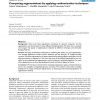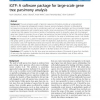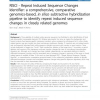192 search results - page 35 / 39 » Genome rearrangements with duplications |
BMCBI
2007
14 years 11 months ago
2007
Background: There exist many segmentation techniques for genomic sequences, and the segmentations can also be based on many different biological features. We show how to evaluate ...
107
click to vote
BMCBI
2007
14 years 11 months ago
2007
Background: Homology is a key concept in both evolutionary biology and genomics. Detection of homology is crucial in fields like the functional annotation of protein sequences and...
107
click to vote
BMCBI
2010
14 years 11 months ago
2010
Background: The ever-increasing wealth of genomic sequence information provides an unprecedented opportunity for large-scale phylogenetic analysis. However, species phylogeny infe...
LATA
2009
Springer
15 years 6 months ago
2009
Springer
Abstract. Gene trees are leaf-labeled trees inferred from molecular sequences. Due to duplication events arising in genome evolution, gene trees usually have multiple copies of som...
130
click to vote
BMCBI
2010
14 years 6 months ago
2010
Background -: The availability of multiple whole genome sequences has facilitated in silico identification of fixed and polymorphic transposable elements (TE). Whereas polymorphic...



